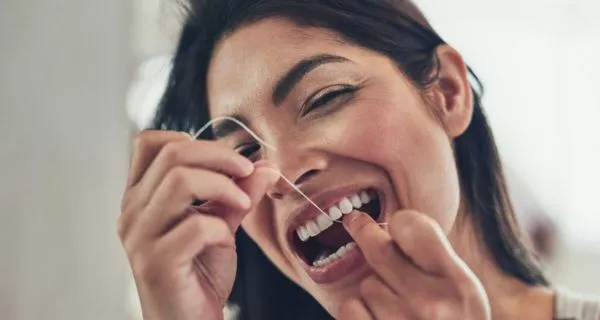Last Updated on: 30th October 2025, 09:17 am
Deep dental cleaning, also called scaling and root planing, is a special treatment that removes plaque and tartar below the gumline. It helps stop gum disease, reduces bleeding, and protects teeth from falling out. Dentists recommend it when regular cleaning is not enough to keep gums healthy.
Dentists usually recommend visiting twice a year for check-ups and cleanings to remove stains and check the health of your teeth and gums.
However, many people skip these visits because of fear or anxiety. Skipping cleanings can lead to problems like gingivitis and periodontitis, which are preventable gum diseases.
When your gums show signs of infection, a regular cleaning is not enough. In these cases, your dentist may suggest a deep dental cleaning, a more thorough procedure that helps stop the infection and restore your oral health.
Table of Contents
ToggleWhat causes gum disease?
Gum disease happens when plaque, a sticky film of food and bacteria, stays too long on your teeth.
This disease is slowly progressive:
- At first, it causes gingivitis, making the gums red and sore.
- If untreated, it becomes periodontitis, a serious infection that damages bone and can cause tooth loss.
Almost half of American adults have some form of gum disease, and it’s more common in men than in women.
What is a deep dental cleaning?
A deep dental cleaning is a professional treatment that cleans under gums. It removes the bacteria, plaque, and tartar that normal brushing or a regular cleaning cannot reach.
This type of cleaning is usually done when there are signs of gum disease, like bleeding, swelling, or loose teeth. It helps stop infection and allows gums to heal and attach again to the teeth.
When do you need a deep cleaning?
You may need a deep cleaning if you have signs of gum disease, which include:
- red, swollen, or bleeding gums
- bad breath that doesn’t go away
- loose teeth or gums pulling away from teeth
- pain or sensitivity when chewing
- gaps between teeth and gums
If your dentist finds infection or pockets around your teeth, they may recommend a deep cleaning to stop gum disease from getting worse.
How is a dental deep cleaning done?
A deep dental cleaning is done in several steps to remove bacteria under the gums and help them heal. It may feel a little uncomfortable, but it should not be painful.
How to prepare for a deep cleaning?
Before the procedure, your dentist will:
- examine your mouth carefully
- take X-rays to see gum pockets and tartar buildup
- check for cavities, loose teeth, or bone loss
- discuss anesthesia if your gums are sensitive
Preparing properly helps the procedure go smoothly and reduces discomfort.
What happens during the cleaning?
The deep cleaning usually includes several steps:
Local anesthesia (If needed)
If your gums are sensitive, the dentist may use a local anesthetic to numb the area. This makes the cleaning more comfortable.
Scaling (plaque and tartar removal)
The dentist uses special tools or ultrasonic devices to remove plaque and tartar above and below the gumline.
Ultrasonic tools use gentle vibrations and water to clean without hurting your gums.
Root planing
After cleaning, the dentist smooths the roots of your teeth. This stops bacteria from sticking again and helps gums reattach to teeth properly.
Antibacterial treatment
Sometimes, the dentist applies an antibiotic gel or prescribes mouthwash or pills to fight infection and speed up healing.
A deep dental cleaning usually takes 1 to 2 hours per visit, depending on how many areas of the mouth require treatment. Some patients may need more than one visit to complete the full cleaning.
What should you do after a deep dental cleaning?
After a deep cleaning, it is normal to feel mild soreness, swollen gums, or sensitivity to hot and cold. These usually go away in a few days.
Your dentist may recommend to:
- Brush gently after 24 hours
- Floss carefully
- Eat soft foods and avoid very hot or hard foods
- Use a soft toothbrush and an antiseptic mouth rinse
Follow-up visits are important to check if your gums are healing well and to remove any remaining bacteria. Most dentists recommend returning 2–3 months after the procedure to make sure your gums are healthy and the cleaning was effective.
What are the advantages and disadvantages of a deep dental cleaning?
A deep dental cleaning is the most effective treatment to stop gum disease and restore healthy gums. Like any procedure, it has important benefits as well as some possible risks that you should know before treatment.
What are the benefits of a deep cleaning?
- Removes tartar and bacteria: reduces inflammation and lowers the risk of infection.
- Prevents and controls gum disease: helps healthy tissue grow back and allows gums to reattach to teeth.
- Improves bad breath: eliminates bacteria that cause chronic halitosis.
- Supports overall health: good oral health can reduce the risk of heart disease, diabetes, and other infections.
- Non-surgical and low-risk: Safe and commonly performed by dentists.
- Prevents tooth loss: Strengthens gums and maintains bone support.
A deep cleaning done correctly, along with good home oral care, can stop the progression of gum disease and improve your dental health significantly.
What are the possible disadvantages or risks?
Although safe, some people may experience temporary side effects or need additional care:
- mild pain or sensitivity during and after the procedure, especially to hot or cold foods.
- slight bleeding or soreness in the gums for a few days.
- infection may not be fully resolved; advanced cases may require antibiotics or extra sessions.
- temporary tooth sensitivity due to root planing.
- small risk of bacteria entering the bloodstream, more common in people with weak immune systems.
- The cost can be higher if multiple sessions are needed or if you don’t have dental insurance.
The benefits of a deep dental cleaning far outweigh the risks when performed by a qualified dentist. Any initial discomfort is temporary, but the results for gum health, teeth, and overall oral well-being are long-lasting.
How much does a deep dental cleaning cost?
The cost of a deep dental cleaning in the United States depends on whether one part of the mouth (a quadrant) or the full mouth is treated:
- per quadrant: $150 – $250 USD
- full mouth: $600 – $1,000 USD
Prices can vary depending on the dental clinic, location, complexity of the treatment, and whether anesthesia, laser treatment, or additional sessions are needed.
How can you access a deep dental cleaning?
There are different ways to get a deep cleaning at a lower cost or with financial help:
- Dental insurance: Many plans cover part or all of the deep cleaning.
- Payment plans or memberships: Some clinics offer financing, discounts, or special membership programs.
- Dental schools: Advanced students perform supervised treatments at lower prices.
- Charitable organizations: For example, the Dental Lifeline Network provides free or low-cost care to eligible patients.
- Community health centers: Offer affordable dental services for people with low income or no insurance.
Where can you get a deep dental cleaning?
If you live in California, Channel Islands Family Dental offers professional deep cleaning and friendly care in Oxnard, Santa Paula, Ventura, Newbury Park, and Port Hueneme.
Their team can check your gums, explain every step, and help restore your healthy smile with modern, comfortable treatments.
A deep dental cleaning is more than just removing plaque; it’s about keeping your smile, gums, and whole body healthy. Don’t wait for pain or bleeding to start. Visit your dentist and take care of your gums before small problems become big ones.
Frequently Asked Questions (FAQ)
Most people recover in 2–5 days. You may feel mild gum swelling, sensitivity to hot or cold foods, or slight bleeding. Following your dentist’s instructions helps your gums heal faster.
Depending on how much of your mouth needs treatment, deep cleaning may be done in one or two visits, sometimes more. Dentists clean in sections (quadrants) to make it more comfortable and effective.
For most healthy adults, it is safe. People with weak immune systems or certain health conditions should discuss risks with their dentist. Rarely, bacteria can enter the bloodstream, so dentists take precautions to minimize this.
Voice Search Snippets (Q&A)
References
1. CDC. (2024, May 15). About periodontal (GUM) disease. Oral Health. https://www.cdc.gov/oral-health/about/gum-periodontal-disease.html
2. Higuera, V. (2025, July 8). The Benefits of Deep Cleaning Teeth. Healthline. https://www.healthline.com/health/deep-cleaning-teeth
3. Kwon, T., Lamster, I. B., & Levin, L. (2020). Current concepts in the management of periodontitis. International Dental Journal, 71(6), 462–476. https://doi.org/10.1111/idj.12630
4. MouthHealthy. (n. d). Scaling and Root Planing. Oral Health Information from the ADA. https://www.mouthhealthy.org/all-topics-a-z/scaling-and-root-planing/
5. WebMD. (2025, February 28). What Is the Cost of a Deep Teeth Cleaning?. https://www.webmd.com/oral-health/what-is-the-cost-deep-teeth-cleaning



















